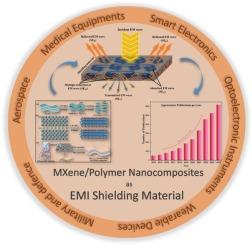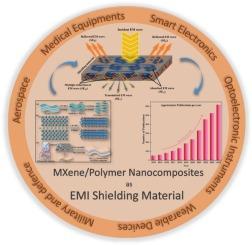Development of MXene based organic polymer nanocomposites as highly efficient Electromagnetic Interference Shielding materials: A review
IF 23.5
1区 化学
Q1 CHEMISTRY, INORGANIC & NUCLEAR
引用次数: 0
Abstract
The rapid expansion of electronic devices and wireless communication technologies has significantly increased the demand for high performance electromagnetic interference (EMI) shielding materials. MXene-based organic polymer nanocomposites have emerged as promising candidates due to their exceptional features including high electrical conductivity, mechanical flexibility, and lightweight properties. This review examines the synthesis and properties of MXenes, particularly their layered structure and multifunctionality, and explores various fabrication methods for MXene/polymer EMI shielding nanocomposites. The advantages and limitations of these methods in EMI applications are critically analysed. Additionally, structural characteristics, including morphology and interface interactions, are discussed to assess the dispersion and stability of MXene within polymer matrices. Key factors influencing shielding effectiveness (SE), such as MXene content, polymer type, and composite thickness, are investigated, along with the fundamental mechanisms governing EMI shielding in these nanocomposites. The contributions of total electromagnetic wave attenuation (SET), including absorption (SEA), reflection (SER), and multiple reflections (SEM), are examined in relation to optimal shielding mechanisms. A comparative analysis with other EMI shielding materials highlights the superior mechanical robustness, flexibility, and processability of MXene/polymer nanocomposites. Finally, the review outlines potential applications in flexible electronics, aerospace, medical, and wearable devices, emphasizing the need for further research on scalability, oxidation resistance, and environmental sustainability. It also addresses current challenges in EMI shielding applications and proposes innovative strategies for developing advanced EMI shielding materials.


MXene基有机聚合物纳米复合材料作为高效电磁干扰屏蔽材料的研究进展
电子设备和无线通信技术的快速发展显著增加了对高性能电磁干扰(EMI)屏蔽材料的需求。基于mxene的有机聚合物纳米复合材料由于其优异的特性,包括高导电性、机械柔韧性和轻质性,已经成为有希望的候选材料。本文综述了MXene的合成和性能,特别是其层状结构和多功能性,并探讨了MXene/聚合物EMI屏蔽纳米复合材料的各种制备方法。分析了这些方法在电磁干扰应用中的优点和局限性。此外,还讨论了MXene的结构特征,包括形态和界面相互作用,以评估MXene在聚合物基质中的分散和稳定性。研究了影响屏蔽效果(SE)的关键因素,如MXene含量、聚合物类型和复合材料厚度,以及这些纳米复合材料屏蔽EMI的基本机制。研究了总电磁波衰减(SET),包括吸收(SEA)、反射(SER)和多次反射(SEM)对最佳屏蔽机制的贡献。与其他电磁干扰屏蔽材料的对比分析突出了MXene/聚合物纳米复合材料优越的机械稳健性、灵活性和可加工性。最后,综述概述了柔性电子、航空航天、医疗和可穿戴设备的潜在应用,强调需要进一步研究可扩展性、抗氧化性和环境可持续性。它还解决了当前EMI屏蔽应用中的挑战,并提出了开发先进EMI屏蔽材料的创新策略。
本文章由计算机程序翻译,如有差异,请以英文原文为准。
求助全文
约1分钟内获得全文
求助全文
来源期刊

Coordination Chemistry Reviews
化学-无机化学与核化学
CiteScore
34.30
自引率
5.30%
发文量
457
审稿时长
54 days
期刊介绍:
Coordination Chemistry Reviews offers rapid publication of review articles on current and significant topics in coordination chemistry, encompassing organometallic, supramolecular, theoretical, and bioinorganic chemistry. It also covers catalysis, materials chemistry, and metal-organic frameworks from a coordination chemistry perspective. Reviews summarize recent developments or discuss specific techniques, welcoming contributions from both established and emerging researchers.
The journal releases special issues on timely subjects, including those featuring contributions from specific regions or conferences. Occasional full-length book articles are also featured. Additionally, special volumes cover annual reviews of main group chemistry, transition metal group chemistry, and organometallic chemistry. These comprehensive reviews are vital resources for those engaged in coordination chemistry, further establishing Coordination Chemistry Reviews as a hub for insightful surveys in inorganic and physical inorganic chemistry.
 求助内容:
求助内容: 应助结果提醒方式:
应助结果提醒方式:


